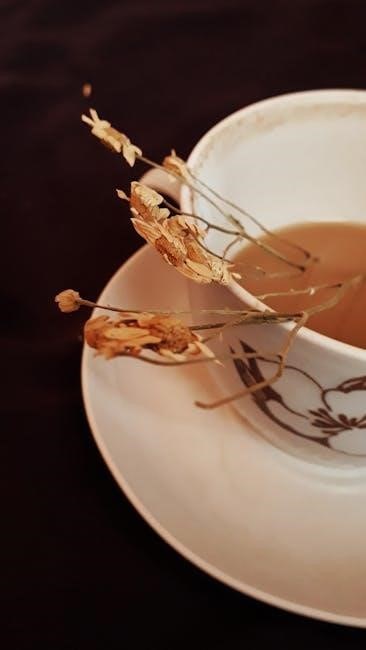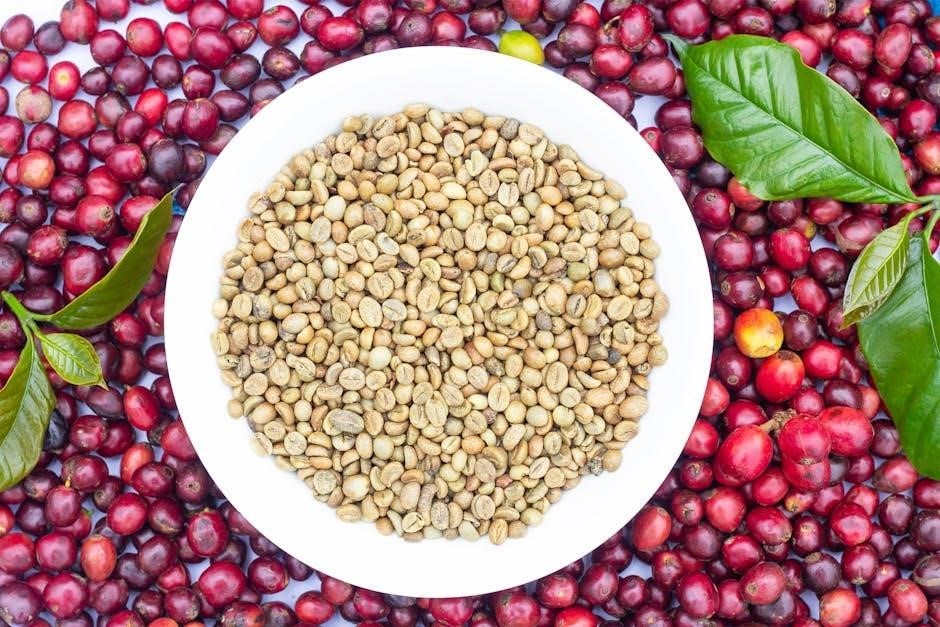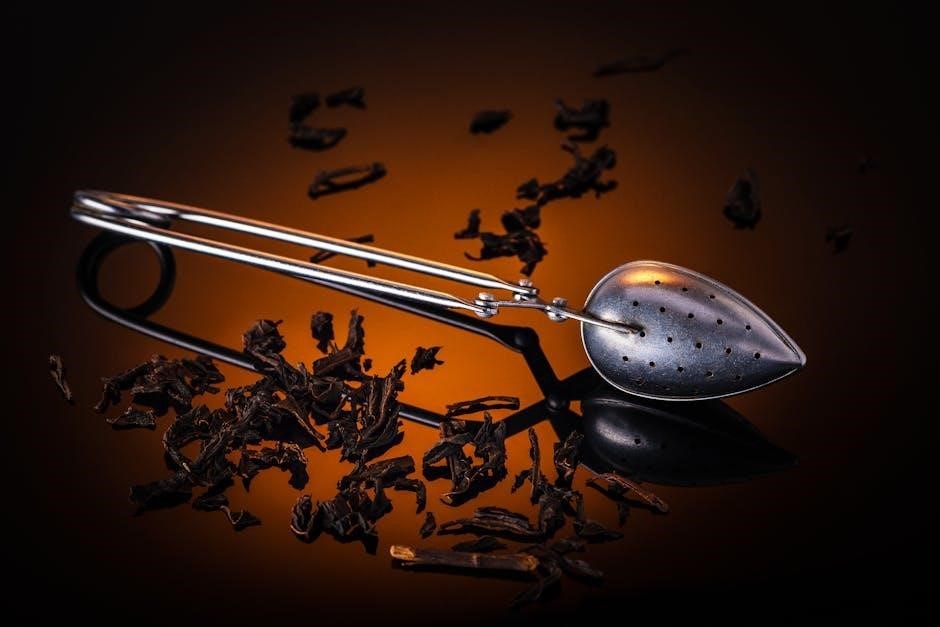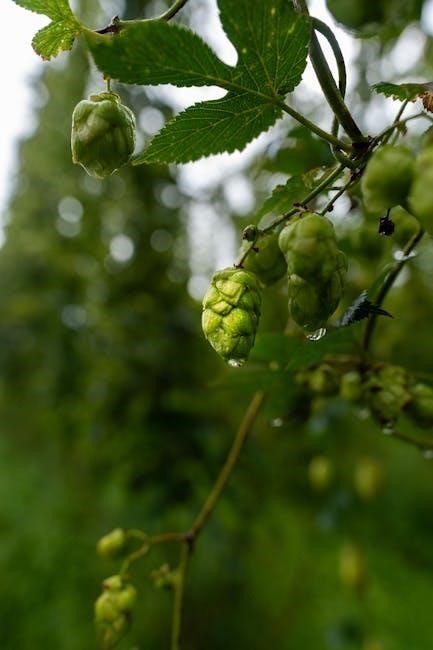This comprehensive guide offers expert techniques for brewing Mei Leaf teas, covering essential methods, optimal teaware, and water quality to enhance flavor and aroma for a perfect cup.
Welcome to the Mei Leaf Brewing Guide, your ultimate resource for mastering the art of tea preparation. Whether you’re a novice or an experienced brewer, this guide offers detailed insights to elevate your tea-drinking experience. Brewing tea is more than just steeping leaves in water; it’s about understanding the nuances of each tea type, from white to puerh, and optimizing every step to bring out their unique flavors and aromas. Mei Leaf Brewing emphasizes the importance of quality ingredients, precise techniques, and the right teaware to ensure a perfect cup every time. Discover how to awaken tea leaves through rinsing, harness the power of water quality, and explore both traditional Gong Fu and Western-style brewing methods. This guide is designed to empower you with the knowledge to experiment and personalize your brewing process, ensuring every sip is a delightful journey of taste and tradition.
Understanding the Basics of Tea Brewing
Brewing tea is an art that begins with understanding its fundamental principles. At its core, tea brewing involves extracting flavors and aromas from tea leaves using hot water. The process requires attention to key elements: water quality, temperature, and steeping time. Each tea type—whether white, green, yellow, oolong, black, or puerh—responds differently to these variables, making it essential to tailor your approach. Water should be fresh and filtered, while temperatures vary depending on the tea’s delicacy. Steeping times range from seconds for delicate teas to minutes for heartier varieties. Rinsing tea leaves before brewing is a crucial step to awaken them, ensuring a balanced extraction. By mastering these basics, you lay the foundation for a perfect cup, allowing the unique characteristics of each tea to shine. This understanding is the starting point for exploring advanced techniques and personalizing your brewing experience.
The Importance of Rinsing Tea Leaves

Rinsing tea leaves is a vital step in the brewing process that often goes overlooked but plays a significant role in achieving optimal flavor and aroma. This simple act of briefly submerging the leaves in hot water serves multiple purposes. First, it awakens the tea leaves, preparing them for infusion by softening their surfaces. This helps release their flavors and aromas more evenly during brewing. Additionally, rinsing removes any impurities or dust that may have accumulated on the leaves, ensuring a cleaner and purer taste. For delicate teas, rinsing also prevents the leaves from being overwhelmed by the initial hot water, reducing bitterness and astringency. Using water at the same temperature as the brewing water enhances this process, as it aligns the leaves with the conditions they will experience during infusion. Regular rinsing is especially recommended for teas with dense or rolled leaves, such as oolong or puerh, to unfurl them properly. By incorporating this step, you set the stage for a balanced and satisfying cup of tea.
Types of Tea and Their Brewing Requirements
Mei Leaf offers brewing guidelines for white, green, yellow, oolong, black, and puerh teas, each requiring unique temperatures, steeping times, and leaf amounts for optimal flavor and aroma.
White Tea Brewing Guidelines
White tea, known for its delicate flavor, requires precise brewing to preserve its subtle aroma and taste. Use filtered water with a temperature of 70-75°C (158-167°F) to avoid scorching the leaves; Measure 1-2 grams of tea leaves per 100ml of water, depending on the specific variety. Steep the leaves for 1-2 minutes for the first infusion and 2-3 minutes for subsequent infusions. Avoid over-steeping, as it can lead to bitterness. For optimal results, use high-quality, pH-neutral water to enhance the tea’s natural sweetness. Gently pour the water over the leaves to ensure even extraction. White teas typically yield 2-3 infusions, with each offering a slightly different flavor profile. Experiment with brewing times to find your preferred balance of delicacy and strength. Pair white teas with light, delicate foods to complement their refined character.
Green Tea Brewing Recommendations
Green tea brewing requires attention to detail to bring out its vibrant, refreshing flavors. Use water at 70-85°C (158-185°F) to avoid bitterness, as green teas are more delicate than black teas. Measure 1-2 grams of loose-leaf tea per 100ml of water for an ideal balance. Rinse the leaves with hot water for a few seconds before the first infusion to awaken the tea. Steep for 1-2 minutes for the first infusion and 2-3 minutes for subsequent infusions, adjusting based on the tea’s strength and your preference. High-quality, filtered water is essential to prevent any impurities from affecting the tea’s taste. For optimal results, use a ceramic or glass teapot, as metal can alter the flavor. Experiment with infusion times to suit your taste, as some green teas may require shorter or longer brewing times. This method ensures a perfectly balanced and refreshing cup every time.
Yellow Tea Brewing Tips
Yellow tea, known for its smooth and floral profile, requires precise brewing to unlock its delicate flavors. Use water at 70-85°C (158-185°F) to avoid overpowering the tea’s subtle notes. Start by rinsing the leaves with hot water for a few seconds to soften them and prepare for infusion. Measure 1-2 grams of loose-leaf tea per 100ml of water for an optimal balance. Steep for 1-2 minutes for the first infusion and 2-3 minutes for subsequent ones, adjusting based on the tea’s strength and your preference. Filtered water is essential to preserve the tea’s natural taste. Yixing teapots or gaiwans are ideal for gong fu brewing, while ceramic or glassware works well for western-style brewing. Allow the tea to cool slightly before sipping to fully appreciate its nuanced aroma. Yellow tea typically yields 3-4 infusions, with each one revealing new layers of complexity. Experiment with infusion times to find your perfect cup.
Oolong Tea Brewing Methods
Oolong tea, known for its complex profile, thrives with versatile brewing techniques. Start by rinsing the leaves with hot water to awaken the tea. Use water at 85-100°C (185-212°F) for more robust oolongs and 75-90°C (167-194°F) for lighter ones. Gong fu brewing is ideal, using 3-5 grams per 100ml in a Yixing teapot or gaiwan. Multiple short infusions (15-30 seconds) allow the tea to unfurl gradually, releasing its full potential. For western-style brewing, use 1-2 grams per 100ml and steep for 2-4 minutes. Adjust infusion times based on the tea’s roast level and personal preference. Oolong teas typically offer 4-6 infusions, with each revealing distinct floral, fruity, or nutty notes. Experiment with temperature and steeping times to tailor the brew to your taste. This method enhances the tea’s intricate aroma and flavor, making oolong a delightful journey for tea enthusiasts.
Black Tea Brewing Best Practices
Black tea brewing requires attention to detail to bring out its robust and rich flavors. Use boiling water (100°C/212°F) for optimal extraction, as black teas can withstand higher temperatures. Measure 1-2 grams of loose-leaf tea per 100ml of water for a balanced brew. Steep for 3-5 minutes, depending on the tea’s strength and your preference. Gong fu brewing is less common for black teas, but western-style methods work well. Use filtered water to avoid impurities that might affect the taste. Ceramic or porcelain teapots are ideal, as they retain heat evenly. For stronger brews, extend the steeping time slightly. Black teas typically yield one to two quality infusions. Experiment with milk or honey if desired, but traditionalists often enjoy it plain to appreciate the tea’s natural complexity. This method ensures a bold, satisfying cup that highlights the tea’s malty and earthy notes.
Puerh Tea Brewing Instructions
Brewing Puerh tea is an art that requires careful steps to unlock its earthy, mellow flavors. Start by rinsing the tea leaves with hot water (around 100°C/212°F) for a few seconds to awaken them. Use 1-2 grams of tea per 100ml of water, depending on the form—loose, cake, or tuocha. For the first infusion, steep for 10-20 seconds, then gradually increase the time for subsequent infusions. Puerh teas can yield up to 8-10 infusions. Use filtered water with a neutral pH to prevent any impurities from affecting the taste. Yixing teapots or gaiwans are ideal for Gong Fu brewing, enhancing the tea’s complexity; The first few infusions are stronger, while later ones become smoother. Enjoy Puerh plain to fully appreciate its nuances. This method ensures a balanced and satisfying experience, bringing out the tea’s unique characteristics.

Brewing Techniques for Mei Leaf Teas
Mei Leaf teas excel with Gong Fu and Western-style brewing. Gong Fu uses small teapots for rich, complex flavors, while Western-style offers a simpler, balanced approach for everyday enjoyment.
Gong Fu Brewing Method
Gong Fu brewing is a traditional Chinese method emphasizing precision and ritual. It involves using Yixing teapots or gaiwans to steep small amounts of tea leaves multiple times. This technique enhances aroma and flavor complexity, allowing each infusion to reveal distinct notes. Water temperature and leaf quantity are crucial, typically using 3-5 grams of tea per 100ml of water. The first rinse softens the leaves, preparing them for brewing. Subsequent infusions vary in timing, starting from 10-30 seconds and increasing slightly with each steep. Gong Fu is ideal for oolong, puerh, and other complex teas, offering a meditative experience that highlights the tea’s full potential. Proper teaware, like clay pots, complements the process by retaining heat and enhancing the tea’s character. This method is perfect for enthusiasts seeking a deeper connection with their tea.
Western-Style Brewing Approach
Western-style brewing is a straightforward method perfect for everyday tea enjoyment. It typically involves using larger teapots or mugs with infusers or strainers. For Mei Leaf teas, ceramic or glassware is recommended to preserve delicate flavors, especially for green, white, and yellow teas. Use one teaspoon of loose-leaf tea per 8 oz of water, adjusting based on personal preference. Water temperature should align with the tea type: 160°F-170°F for black teas, 150°F-160°F for oolong, and 140°F-150°F for green, white, and yellow teas. Steeping times range from 2-5 minutes, depending on the tea’s strength desired. This approach allows for a single, longer infusion, making it convenient for those seeking simplicity. Filtered water with a neutral pH (7-8) is ideal to avoid imparting unwanted flavors. Western-style brewing offers versatility, accommodating both single infusions and multiple steeps, making it a practical choice for various tea types and preferences.
Teaware for Optimal Brewing
Choosing the right teaware enhances the brewing experience. Materials like ceramic, glass, or Yixing teapots complement tea flavors, ensuring optimal aroma and taste extraction during the brewing process.
Materials for Teaware and Their Impact
Teaware materials significantly influence the brewing experience; Ceramic and glassware are ideal for delicate teas, preserving subtle flavors and aromas. Yixing clay teapots, known for their porous nature, enhance the complexity of oolong and pu-erh teas by absorbing and releasing flavors over time. Porcelain retains heat effectively, making it suitable for black teas that require consistent warmth. Bamboo and wood accents add a rustic charm while maintaining a neutral flavor profile. Each material interacts uniquely with tea, ensuring a balanced extraction of flavors. Choosing the right material can elevate the tea’s natural characteristics, making it essential to pair teaware with the specific tea type for an optimal experience. This harmony between teaware and tea leaves is a cornerstone of the Mei Leaf brewing philosophy.

Recommended Teaware for Mei Leaf Teas
For an optimal brewing experience, Mei Leaf recommends specific teaware based on tea type. Yixing teapots and gaiwans are ideal for Gong Fu brewing, enhancing aroma and flavor, especially for oolong and pu-erh teas. Ceramic or glassware is perfect for delicate teas like white and green, as they preserve subtle flavors. Porcelain teapots retain heat well, making them suitable for black teas. Bamboo or wooden teaware adds a natural aesthetic while maintaining a neutral flavor profile. The choice of teaware should complement the tea’s unique profile, ensuring a balanced extraction of flavors and aromas. By selecting the right vessel, you can elevate the tea-drinking experience and fully appreciate the craftsmanship of Mei Leaf teas. This thoughtful pairing of teaware and tea leaves is central to achieving the perfect brew.

Water Quality and Brewing
Water quality significantly impacts tea flavor. Use filtered or spring water with a neutral pH to avoid harsh chemicals and ensure a pure, balanced taste experience for Mei Leaf teas.
The Role of Water in Tea Brewing
Water plays a crucial role in tea brewing, as it directly affects the extraction of flavors and aromas. Using high-quality, filtered water ensures a clean and balanced taste, free from impurities. Tap water can contain minerals that alter the tea’s profile, so it’s recommended to avoid it. Instead, opt for filtered or spring water with a neutral pH, typically between 7 and 8, to bring out the optimal characteristics of your tea. Additionally, water temperature is essential, as it influences the infusion process. For delicate teas like green or white, cooler temperatures are preferred, while black or pu-erh teas thrive in boiling water. Proper water preparation is the foundation for a perfect cup of Mei Leaf tea, enhancing the overall brewing experience and allowing the tea’s true essence to shine.
Recommended Water Temperature for Brewing
Choosing the right water temperature is vital for brewing tea optimally. For delicate teas like green, white, and yellow, use water between 70°C to 85°C (158°F to 185°F) to prevent bitterness and preserve subtle flavors. Oolong teas thrive at slightly higher temperatures, typically between 80°C to 90°C (176°F to 194°F), depending on their roast level. Black and pu-erh teas can handle boiling water, around 100°C (212°F), to bring out their robust profiles. Adjust the temperature based on the tea’s specific requirements and your personal preference for strength. Using a thermometer ensures precision, but experienced brewers often gauge it by eye. Remember, the right temperature enhances the tea’s natural characteristics, making each sip more enjoyable and authentic to its type.

Brewing Process and Timing
Brewing tea involves precise steps: measuring leaves, heating water, rinsing, and steeping. Timing varies by tea type, with infusions ranging from 20 seconds to 5 minutes for optimal flavor extraction.
Step-by-Step Brewing Instructions
To brew tea like a pro, start by heating fresh, filtered water to the recommended temperature for your tea type. Prepare your teaware by rinsing it with hot water to ensure even heat distribution. Measure the tea leaves according to the guide—typically 1-2 grams per 100ml of water. Gently rinse the leaves with a quick pour of hot water to awaken them. Discard the rinse water and begin the first steep, timing it precisely based on the tea type: 20-30 seconds for delicate teas and up to 5 minutes for robust ones. Repeat for multiple infusions, adjusting steeping times slightly after the first. Pour the tea into cups or a serving pot, and enjoy the nuanced flavors and aromas. Experiment with parameters to tailor the experience to your taste preferences.
Infusion Times for Different Tea Types
Infusion times vary significantly across tea types, ensuring optimal flavor extraction. For delicate white teas, steep for 2-3 minutes at 70-80°C (158-176°F). Green teas typically require 1-2 minutes at 60-80°C (140-176°F), while yellow teas benefit from slightly longer, 2-3 minutes at similar temperatures. Oolong teas can range from 2-5 minutes, depending on oxidation levels, with water at 85-95°C (185-203°F). Black teas are best steeped for 3-5 minutes at boiling point (100°C/212°F). For puerh teas, use multiple short infusions of 20-30 seconds each, repeating up to 6 times. Adjust times based on personal preference and leaf size. Shorter infusions preserve subtle notes, while longer times enhance strength and body. These guidelines provide a foundation for experimentation, allowing you to tailor the brewing process to your taste preferences and the unique characteristics of each tea.
The Mei Leaf Brewing Guide provides a comprehensive roadmap for mastering the art of tea brewing, offering insights tailored to enhance your tea experience. From understanding the fundamentals of tea types to optimizing brewing techniques, this guide equips you with the knowledge to bring out the full potential of your tea leaves. Whether you prefer the traditional Gong Fu method or a Western-style approach, the principles outlined here serve as a foundation for experimentation and personalization. Remember, the perfect cup is a balance of tradition, quality ingredients, and individual preference. By adhering to the guidelines and exploring different techniques, you can elevate your tea-drinking journey and savor the unique nuances of each tea. Embrace the process, refine your skills, and enjoy the delightful world of tea with Mei Leaf as your guide.